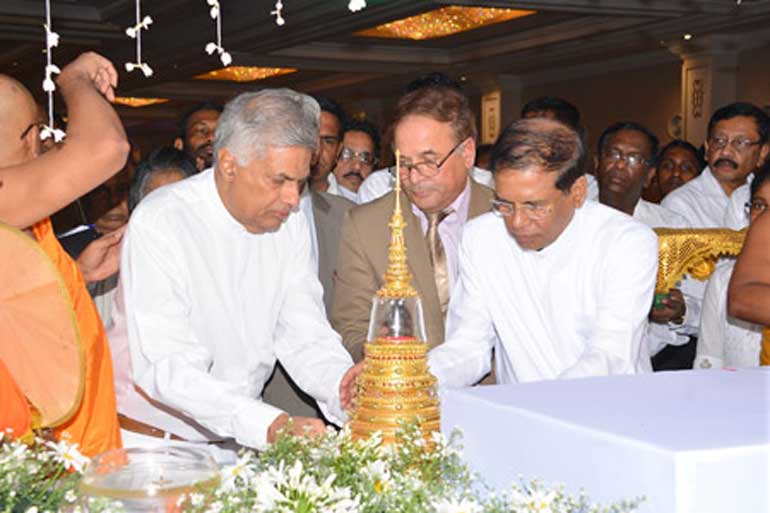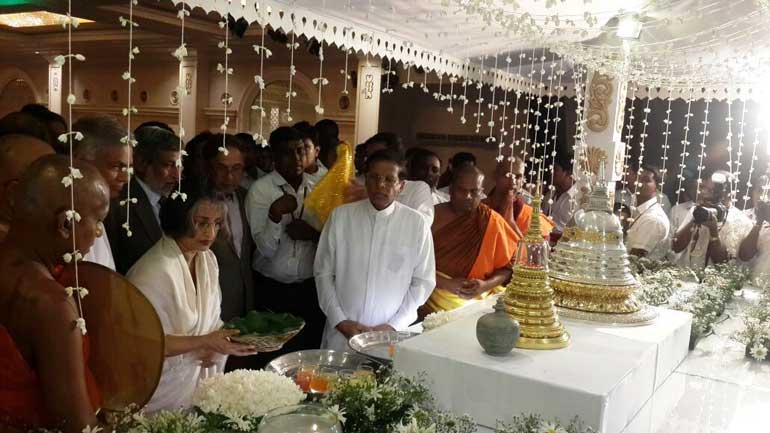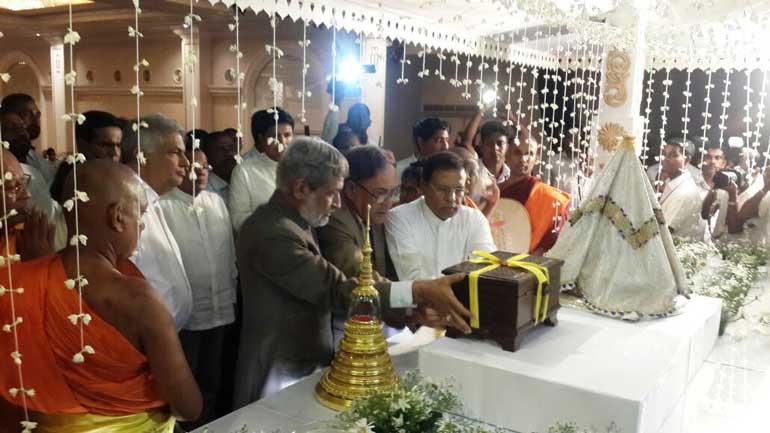Tuesday Dec 09, 2025
Tuesday Dec 09, 2025
Saturday, 28 May 2016 00:00 - - {{hitsCtrl.values.hits}}

President Maithripala Sirisena and Prime Minister Ranil Wickremesinghe along with Curator of Taxila Museum Pakistan inaugurating the Sacred Relics

President Maithripala Sirisena, PM Ranil Wickremesinghe and Maithree Wickremesinghe paying homage to the Sacred Relics

President Maithripala Sirisena, Pakistan’s Secretary National History Mohsin Haqqani and Curator Taxila Museum placing the Sacred Relics for exposition
Sri Lankan President Maithripala Sirisena and Prime Minister Ranil Wickremesinghe inaugurated the exposition of the most Sacred Relics of Lord Buddha brought from Pakistan, in an impressive ceremony at Temple Trees last evening, for public exposition.
A large number of senior monks/religious scholars, Speaker of the Sri Lankan Parliament Karu Jayasuriya, senior government ministers, high level government officials, Secretary Heritage Pakistan Mohsin Haqqani, Deputy High Commissioner of Pakistan, Dr. Sarfraz Sipra, Curator of Taxila Museum as well as officers of the High Commission attended the inaugural ceremony.
The sacred relics include two holy bone relics of the Buddha, a golden casket containing the relics and a stone reliquary in stupa shape. These holy relics are part of collection from Taxila Museum of Pakistan, which is located at one of the most important archaeological sites in Asia.
The holy relics will be in Colombo for a four-day public exposition from 21 to 24 May. After that the relics will be taken to Gampaha (25-26 May), Kurunegala (27-28 May), Kalutara (29 May-1 June), Ratnapura (2-3 June), Galle (4-5 June), Matara (6-7 June), Hambantota (8-9 June), Moneragala (10-11 June), Badulla (12-13 June), Ampara (14-15 June), Polonnaruwa (16-17 June), Anuradhapura (18-19 June) and Kandy (20-21 June). Afterwards, the relics will be brought back to Colombo on 22 June.
The relic casket of steatite with a miniature gold casket inside, containing holy bone relics were found near the Dharmarajika stupa. The steatite casket is 7.5 inch high and has been well turned on the lath. It has adorned with shallow incised lines round its body and provided with handle on the led in the shape of a miniature casket.
Dharmarajika stupa is the earliest and the largest Buddhist religious complex at Taxila. It is situated on the bank of Dharma rivulet. It was built to enshrine the redistributed holy relics of the Buddha by the famous Mauryan king Asoka the great who was also known as Dharmaraja for his services to Buddhism. Thus it named Dharmarajika.
Dharmarajika was excavated by Ghulam Qadir in 1912-16 under the directions of Sir John Marshall and A.D. Siddiqui in 1934-36. The circular stupa has a diameter of 131 feet and 45 feet high drum, constructed in solid stone masonry.
The Gandhara civilisation was not only the centre of spiritual influence but also the cradle of the world famous Gandhara culture, art and learning. It was from these centres that a unique art of sculpture originated which is known as Gandhara Art all over the world.